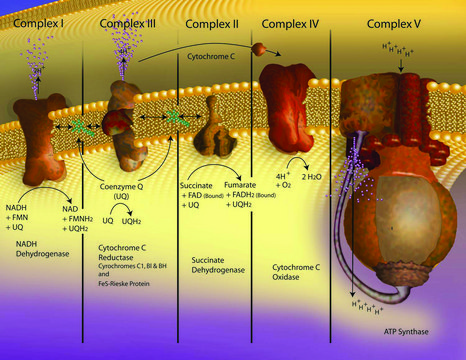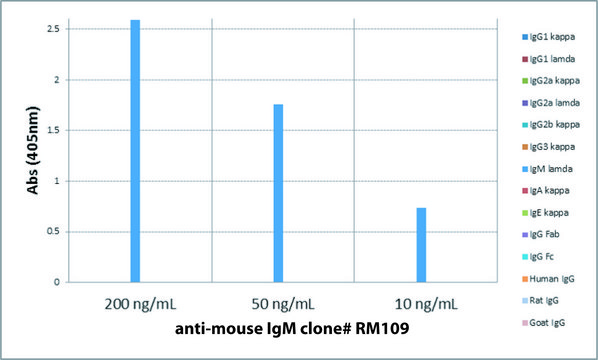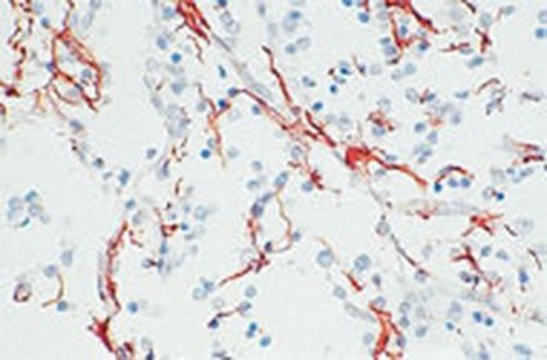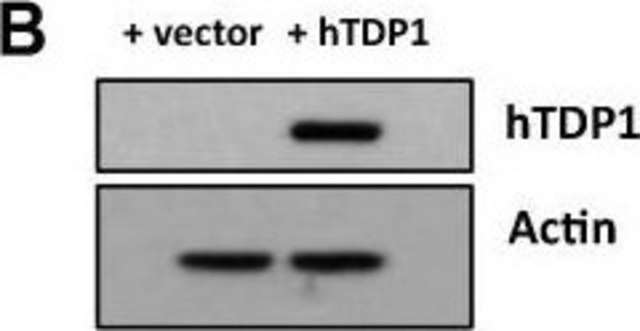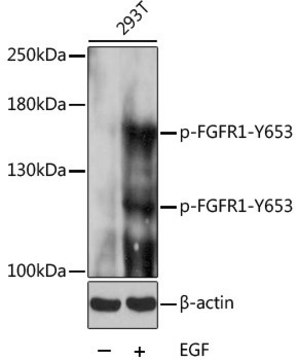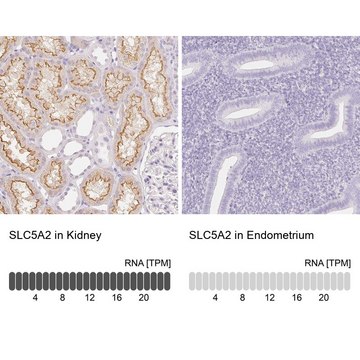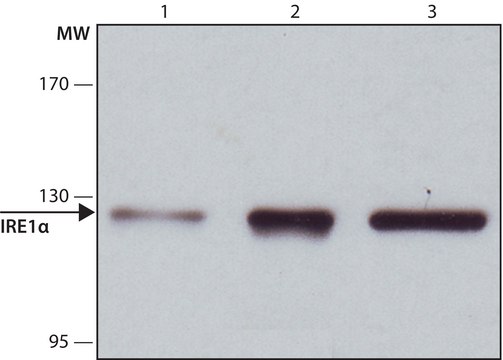一般描述
We are committed to bringing you greener alternative products, which adhere to one or more of The 12 Principles of Green Chemistry.This antibody is Preservative-free, produced without the harm or sacrifice of animals and exceptionally stable to allow for ambient shipping and storage if needed and thus aligns with "Waste Prevention", "Designing Safer Chemicals" and "Design for Energy Efficiency".
Click here for more information.
ZooMAb® antibodies represent an entirely new generation of recombinant monoclonal antibodies.Each ZooMAb® antibody is manufactured using our proprietary recombinant expression system, purified to homogeneity, and precisely dispensed to produce robust and highly reproducible lot-to-lot consistency. Only top-performing clones are released for use by researchers. Each antibody is validated for high specificity and affinity across multiple applications, including its most commonly used application. ZooMAb® antibodies are reliably available and ready to ship when you need them.
特异性
Clone 1H14 is a ZooMAb® rabbit recombinant monoclonal antibody that specifically detects the large subunit of Calpain-1. It targets an epitope within 20 amino acids from domain II region.
免疫原
KLH-conjugated linear peptide corresponding to 20 amino acids from the domain II from the N-terminal half of human Calpain-1.
应用
Quality Control Testing
Evaluated by Western Blotting in MOLT-4 cell lysate.
Western Blotting Analysis: A 1:1,000 dilution of this antibody detected Calpain-1 in MOLT-4 cell lysate.
Tested applications
Western Blotting Analysis: A 1:1,000 dilution from a representative lot detected Calpain-1 in lysates from C2C12 and Jurkat cells, and Mouse kidney lysate.
Immunohistochemistry (Paraffin) Analysis: A 1:100 dilution from a representative lot detected Calpain-1 in human small intestine tissue sections.
Immunocytochemistry Analysis: A 1:100 dilution from a representative lot detected Calpain-1 in MCF-7 cells.
Note: Actual optimal working dilutions must be determined by end user as specimens, and experimental conditions may vary with the end user
Evaluated by Western Blotting in MOLT-4 cell lysate.
Western Blotting Analysis: A 1:1,000 dilution of this antibody detected Calpain-1 in MOLT-4 cell lysate.
目标描述
Calpain-1 catalytic subunit (UniProt: P07384; also known as EC:3.4.22.52, Calcium-activated neutral proteinase 1, CANP 1, Calpain mu-type, Calpain-1 large subunit, Cell proliferation-inducing gene 30 protein, Micromolar-calpain, muCANP) is encoded by the CAPN1 (also known as CANPL1, PIG30) gene (Gene ID: 823) in human. Calpains belong to a family of non-lysosomal, calcium-dependent thiol proteases that proteolyze a wide variety of cytoskeletal, membrane-associated, and regulatory proteins. It is a cytosolic enzyme that translocates to the plasma membrane upon Ca2+ binding. Typical calpains are characterized by a C-terminal Ca2+-binding domain that includes EF-hand motifs, while atypical calpains lack this region, but often contain additional domains. Calpains respond to calcium signals by cleaving specific proteins that are frequently components of signaling cascades, thereby irreversibly modifying their function. Two major isoforms of calpain are reported in mammals, calpain-1 and calpain-2 that are constitutively expressed in all tissues and differ in their calcium requirement for activation (~50 M for calpain-1 and ~500 M for calpain-2). They are composed of non-covalently linked 80 kDa subunit that contains the catalytic subunit (aa 55-354) and a 30 kDa subunit with a regulatory subunit. The 80 kDa subunit consists of four domains (I - IV) and the 30 kDa unit has 2 domains (V and VI). Domain I is partially removed during autolysis. Domain II is the protease domain, which is structurally similar to the catalytic domain of other cysteine proteases. It contains a Cys, His, Asn triad characteristic of cysteine proteases. Domain III exhibits homology with typical calmodulin binding proteins and interacts with calcium binding domains (IV and VI) freeing domain II for protease activity. Domain IV is a Ca2+-binding domain structurally similar to calmodulin. Domain V contains a hydrophobic region and is essential for calpain interaction with membranes. Domain VI has five EF-hands. There are two EF-hand pairs, one pair (EF1-EF2) displays an open conformation and the other (EF3-EF4) displays a closed conformation. The fifth EF-hand (EF5) has closed conformation. Over-expression of calpains has been positively linked to both acute and chronic neurodegenerative processes including ischemia, trauma, and Alzheimer s disease. In Alzheimer s disease the ratio of active to inactive calpain-1 is reported to be much higher. Calpain proteolysis is usually the late-stage common pathway towards cell death induced by excitotoxic compounds. This ZooMAbZooMAb® recombinant monoclonal antibody, generated by our propriety technology, offers significantly enhanced specificity, affinity, reproducibility, and stability over conventional monoclonals.
外形
Purified recombinant rabbit monoclonal antibody IgG, lyophilized in PBS, 5% Trehalose, normal appearance a coarse or translucent resin. The PBS/trehalose components in the ZooMAb formulation can have the appearance of a semi-solid (bead like gel) after lyophilization. This is a normal phenomenon. Please follow the recommended reconstitution procedure in the data sheet to dissolve the semi-solid, bead-like, gel-appearing material. The resulting antibody solution is completely stable and functional as proven by full functional testing. Contains no biocide or preservatives, such as azide, or any animal by-products. Larger pack sizes provided as multiples of 25 μL.
重悬
30 μg/mL after reconstitution at 25 μL per vial. Please refer to guidance on suggested starting dilutions and/or titers per application and sample type.
储存及稳定性
Recommend storage of lyophilized product at 2-8°C; Before reconstitution, micro-centrifuge vials briefly to spin down material to bottom of the vial; Reconstitute each vial by adding 25 μL of filtered lab grade water or PBS; Reconstituted antibodies can be stored at 2-8°C, or -20°C for long term storage. Avoid repeated freeze-thaws.
法律信息
ZooMAb is a registered trademark of Merck KGaA, Darmstadt, Germany
免责声明
Unless otherwise stated in our catalog or other company documentation accompanying the product(s), our products are intended for research use only and are not to be used for any other purpose, which includes but is not limited to, unauthorized commercial uses, in vitro diagnostic uses, ex vivo or in vivo therapeutic uses or any type of consumption or application to humans or animals.

